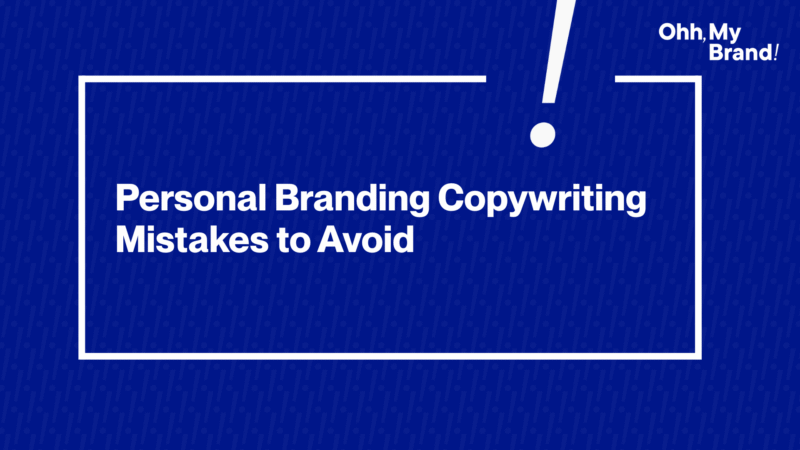Crafting a strong personal brand is not just about having a LinkedIn profile or a catchy bio. It is about communicating who you are in a way that resonates and builds trust.
Content shared by individuals tends to receive significantly more engagement on social media than content from companies. This shows the power of personal branding when done right. However, for founders and CEOs aiming to stand out, a few subtle copywriting mistakes can quietly sabotage their efforts. From vague statements that confuse readers to an overly polished tone that feels unnatural, even small errors in your personal brand messaging can erode credibility.
The good news is that by recognizing these pitfalls and using better practices, you can write compelling, persuasive, and authentic branding content that enhances your reputation. This guide explores the most common personal branding copywriting mistakes, explains how they affect your brand, and offers clear strategies to correct them. You will also see real examples from successful thought leaders and content by Ohh My Brand that demonstrate what excellent personal branding copy looks like.
Let’s dive in.
Common Personal Branding Copywriting Mistakes
Effective personal branding copy needs clarity, consistency, and authenticity. But even seasoned professionals fall into avoidable traps. Let’s look at the most frequent copywriting errors and why they harm your credibility.
Mistake 1: Vague or Generic Messaging
If your brand message could apply to anyone, it connects with no one.
Statements like “I’m passionate and skilled” offer no clarity. They sound safe, but they don’t distinguish you. In personal branding, vague messages fail to create a strong impression and often make you seem unsure or forgettable.
Why it hurts: People don’t trust what they don’t understand. A fuzzy message makes you seem unclear, possibly even evasive. For example, saying you “leverage synergies to create value” is meaningless to most readers. Compare that to “I help healthcare startups secure funding by connecting them with the right investors.” One tells a story. The other gets ignored.
Mistake 2: An Inauthentic or Overly Polished Tone
Your brand should reflect who you truly are, not what you think a professional “should” sound like.
Copy filled with buzzwords or written in stiff corporate language often feels cold. Worse, it comes off as inauthentic. In today’s world, authenticity is non-negotiable. Audiences respond to real people, not curated perfection.
Why it hurts: When your tone feels fake, trust evaporates. Readers sense when something feels “off.” A personal brand that feels too polished or distant misses the chance to connect emotionally. Sharing a real story or even a past failure shows humility and builds human connection.
Mistake 3: Overuse of Jargon and Buzzwords
Language like “visionary disruptor” or “leveraging paradigms” might sound impressive, but it rarely means much.
Overloading your copy with jargon can alienate readers. It hides your message behind fluff and makes people question your authenticity or intelligence.
Why it hurts: Complexity causes confusion. A reader who doesn’t understand your language will likely stop reading. Worse, they may assume you’re trying to hide a lack of substance. Plain, direct language always communicates more powerfully.
Mistake 4: Inconsistency in Messaging
One of the fastest ways to erode trust is by sounding different across platforms.
Maybe your website sounds casual and relatable, but your LinkedIn bio reads like a corporate brochure. Or your email signature is inspirational, but your social posts are sarcastic.
Why it hurts: Inconsistent tone and messaging make your brand feel unstable. It creates uncertainty about who you really are. People trust consistency. When every touchpoint reinforces the same message and personality, your brand becomes more memorable and credible.
Mistake 5: Overemphasizing Self-Promotion
Yes, your personal brand is about you. But if every piece of copy screams “look at me,” people tune out.
It’s a common mistake: posts that feel like resumes, bios that only brag, or content that exists solely to sell.
Why it hurts: People avoid content that feels like a constant sales pitch. If your copy is always about your wins, your product, or your genius, it feels transactional. Trust is built when you offer value before you ask for attention. Share insights, not just achievements.
Mistake 6: Lack of a Clear Value Proposition or Vision
Sometimes people list their titles, roles, and skills but forget to answer the real question: What’s in it for your audience?
If your copy doesn’t clarify the value you bring or the change you create, it becomes forgettable.
Why it hurts: Without a clear value proposition, your audience sees no reason to care. A personal brand should highlight the impact you create. What problem do you solve? Who benefits from your expertise? Strong branding connects your story to your audience’s needs.
Mistake 7: Misrepresenting or Exaggerating Expertise
Overinflating your experience might work short term, but it’s a long-term disaster.
Claiming expertise you don’t have or using buzzword-heavy titles can lead to lost trust once people find the truth.
Why it hurts: When your audience realizes you exaggerated, your credibility collapses. Even slight embellishments (like calling yourself a “world-renowned expert” after one podcast) can make people question everything else you say. Honesty matters. Always lead with real strengths.
Mistake 8: Neglecting the Audience
Personal branding is personal, but it’s never just about you.
If your writing feels like a monologue, or if you ignore comments and feedback, your audience may feel disconnected.
Why it hurts: When people don’t feel seen, they disengage. If your tone doesn’t speak their language or address their needs, your message will miss the mark. Engaging content feels like a conversation, not a performance. Listening and responding are part of the branding process.
Quick Reference: Mistakes, Consequences, and Corrections
This section offers a high-level summary of the most common personal branding copywriting mistakes, how they harm your brand, and how to fix them effectively.
| Mistake | How It Damages Your Brand | How to Fix It |
| Vague or generic messaging | Confuses your audience and makes your brand forgettable. They won’t understand your value. | Be specific. Use clear, concrete language. Explain exactly what you do and who you help. |
| Inauthentic tone (too polished) | Makes you seem fake or insincere. Readers feel disconnected and suspicious. | Write like you speak. Share real stories, admit challenges, and sound human. |
| Overusing jargon and buzzwords | Creates confusion. Sounds like fluff. Readers may feel excluded or mistrustful. | Use simple, accessible words. Cut the hype. Clarity always wins. |
| Inconsistent messaging or voice | Creates confusion. Makes it hard for people to understand or remember who you are. | Keep your tone and message consistent across platforms. Reinforce the same themes and values. |
| Excessive self-promotion | Feels pushy or self-absorbed. Audiences tune out when it’s all about you. | Focus on your audience. Share insights and helpful content. Promote yourself occasionally, not always. |
| No clear value proposition | Makes your copy unpersuasive. People won’t see why they should care. | Spell out the value you offer. Connect your skills to outcomes that matter to your audience. |
| Exaggerating or misrepresenting | Destroys trust once discovered. Even small exaggerations can damage credibility. | Be honest. Share real accomplishments. Let your integrity speak louder than hype. |
| Ignoring the audience | Feels disconnected or irrelevant. Your content will miss the mark. | Know your audience. Speak to their needs. Ask questions and respond when they engage. |
| Sloppy writing (grammar, structure) | Makes you look unprofessional or careless. Hurts your brand’s credibility. | Always proofread. Use editing tools or get feedback. Clean copy builds trust and authority. |
Each of these mistakes chips away at your authority. But with clear corrections, you can turn your messaging into a strength.
Strategies for Compelling and Authentic Personal Branding Copy
Once you know the mistakes to avoid, the next step is to elevate your writing. These strategies will help make your copy clear, persuasive, and trustworthy.
Define Your Core Message and Value
Start by asking yourself two essential questions:
- What do I want to be known for?
- Who am I helping?
Once you clarify these, write a personal brand statement that reflects both. Keep it short and specific. For example, “I help small businesses grow through simple marketing strategies” is far more effective than “I’m passionate about digital success.”
This one-liner becomes the foundation for everything else you write. It keeps your messaging consistent and focused.
Speak Your Audience’s Language
Use words your audience understands. Avoid technical jargon unless your audience expects it. Match your tone to the people you want to attract.
If your ideal clients are creatives, you might use warm, inspiring language. If you’re speaking to investors, a confident, forward-thinking tone might be more appropriate.
Also, mirror your audience’s pain points and goals. If they’re struggling with visibility, speak directly to that. Say, “I help consultants go from hidden to top-of-mind,” rather than, “I teach branding strategies.”
Be Specific and Concrete
Generic claims are forgettable. Real details stick.
Instead of saying, “I’ve helped many clients,” try, “I’ve helped five SaaS founders increase conversions by 30% within six months.” Add numbers, timeframes, or names if appropriate.
Details build credibility and trust. When people see proof, they believe you can deliver.
Adopt an Authentic, Human Voice
Write like a real person. Use your natural tone. If you’re warm and expressive in conversation, let that come through in your copy. If you’re dry and witty, that works too.
Share honest stories, small struggles, or meaningful experiences. This kind of storytelling doesn’t make you less professional. It makes you more human.
Your brand voice should feel like a handshake, familiar and consistent across every touchpoint.
Focus on Benefits to the Audience
Your reader wants to know one thing: what’s in it for them?
Even when you talk about yourself, always frame it through the lens of how it helps others. Instead of “I host a podcast,” write “I host a weekly podcast that helps startup founders grow their audience without ads.”
Make your audience the hero. Position yourself as the guide. Help them see what they’ll gain by working with, following, or trusting you.
Show, Don’t Just Tell
If you want to be seen as a great leader, don’t just say you are, show how you lead.
A quick example or short story often does more to prove your value than five adjectives ever could. For instance, “After my team’s funding fell through, I helped us land a new investor in three weeks by reworking our entire pitch deck.”
That sentence paints a picture. People believe stories more than self-praise.
Client quotes, screenshots, and project results also help “show” your credibility in action.
Keep it Simple and Accessible
Great copy isn’t complicated. It’s clear.
Write short paragraphs. Use common words. Break long ideas into readable chunks. Whether someone is reading your website or your LinkedIn profile, they should never have to read a sentence twice to understand it.
Simple writing reflects confidence and respect for the reader’s time. It also boosts trust, especially among high-level audiences.
Maintain Consistency (but Tailor for Platform)
Your voice should stay the same everywhere, but your format can shift depending on the platform.
Your website bio might be a detailed story. Your LinkedIn about section might focus on achievements. Your Instagram might be more casual. That’s fine as long as it still sounds like you.
Create a mini style guide for yourself. Note your preferred tone, themes, phrases, and visuals. Use it to check that your messaging feels cohesive no matter where it’s shared.
Provide Value Before Asking for Anything
One of the best ways to build trust is to give first. Share useful tips, insights, or encouragement without asking for a sale right away.
This approach, sometimes called “give, give, give, ask,” makes people far more open to hearing from you when you finally do make an offer.
On platforms like LinkedIn or your personal newsletter, focus 80% on providing value and only 20% on promotion. That ratio keeps your audience engaged and coming back for more.
Edit Ruthlessly and Eliminate Errors
Even powerful ideas lose impact if they’re buried in typos or clunky writing.
Proofread everything. Run it through editing tools. Read it out loud. Get a second pair of eyes on your most important bios and profiles.
Clean, polished writing reflects care. It shows you take yourself and your audience seriously.
Leverage Storytelling and Personal Examples
Your personal brand is more than facts; it’s your journey.
Stories are what people remember. Whether it’s why you started your business, a turning point in your career, or a challenge you overcame, your story creates connection.
You don’t need to write an autobiography. Just one clear, vivid story can build trust faster than a list of skills ever could.
Invite Engagement and Be Responsive
Your personal brand is not a monologue. It’s a conversation.
In your copy, invite people to engage. Ask questions. Open up comment sections. End posts with “What’s your take?” or “Have you experienced this too?”
And when people respond, reply. Responding builds loyalty. It shows that you’re not just broadcasting; you’re listening.
Conclusion: Build Your Brand with Clarity and Trust
Personal branding copywriting isn’t just about writing well. It’s about building trust, showing up consistently, and speaking to real people in a real voice.
The most common mistakes – like being vague, overly polished, jargon-heavy, or self-focused – all share one root problem. They disconnect you from your audience. They dilute your message. They create doubt instead of confidence.
But once you shift your focus to clarity, authenticity, and audience-first communication, your copy starts working for you. It creates pull. It builds credibility. It sparks the kind of attention and respect that opens doors.
Whether you’re writing a headline, a speaker bio, a founder intro, or a simple LinkedIn post – remember:
Speak clearly. Sound like you. Focus on them.
That’s the copywriting formula for a personal brand that feels human, helpful, and worth trusting.
So go audit your current copy. Find one area you can improve. Then another. And another. Your personal brand will thank you.








